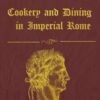Your bag is empty
Don't miss out on great deals! Start shopping or Sign in to view products added.
Shop What's New Sign in$25.82 Save:$13.00(33%)
Available in stock
| Print length: | 538 pages |
|---|---|
| Language: | English |
| Publication date: | 30 March 2024 |
| Dimensions: | 15.24 x 3.1 x 22.86 cm |
| ISBN-13: | 979-8321402276 |
| Format | Paperback |
|---|
Ingredients and Cuisine : Roman cuisine was diverse and influenced by the regions and cultures within the vast empire. Common ingredients included grains like wheat, barley, and millet; vegetables such as lettuce, cabbage, and onions; fruits like grapes, figs, and olives; meats such as pork, lamb, and poultry; seafood; and dairy products. Spices and herbs were used for flavoring, including pepper, cumin, coriander, and saffron. Cooking Techniques : Romans used various cooking methods including boiling, roasting, baking, frying, and stewing. They utilized simple kitchen tools such as pots, pans, mortars, and knives. Wealthier households had more advanced cooking equipment. Recipes and Cookbooks : While there is no surviving comprehensive cookbook from Imperial Rome, “”Apicius de re Coquinaria”” attributed to Apicius contains a collection of recipes and culinary techniques. The recipes in Apicius cover a wide range of dishes including appetizers, main courses, sauces, and desserts. Dining Customs : Meals were important social events and often served as occasions for entertainment and networking. Dining typically occurred in a triclinium, a dining room with couches arranged around a low table. Guests reclined on these couches while dining. Meals consisted of multiple courses including appetizers (gustatio), main courses (primae mensae), and desserts (secundae mensae). Wine, typically diluted with water, was a common beverage served during meals. Etiquette and Rituals : Dining etiquette was formalized with rules governing seating arrangements, serving order, and proper behavior. Guests were expected to wash their hands before meals and engage in polite conversation. Hosts sometimes provided entertainment such as music, poetry recitations, or performances by hired entertainers. Social Significance : Dining habits varied based on social status, with the wealthy indulging in more elaborate feasts and exotic ingredients. Banquets and dinner parties were opportunities for the elite to display their wealth and status. Legacy : Roman culinary traditions have influenced subsequent Western cuisines, with elements of Roman cooking still present in modern dishes and dining customs. Cookery and dining in Imperial Rome were not only about sustenance but also about socializing, cultural expression, and the display of wealth and status. They offer valuable insights into the daily lives and customs of ancient Romans. —- ISBN: 9798321402276
Only logged in customers who have purchased this product may leave a review.

Reviews
There are no reviews yet.